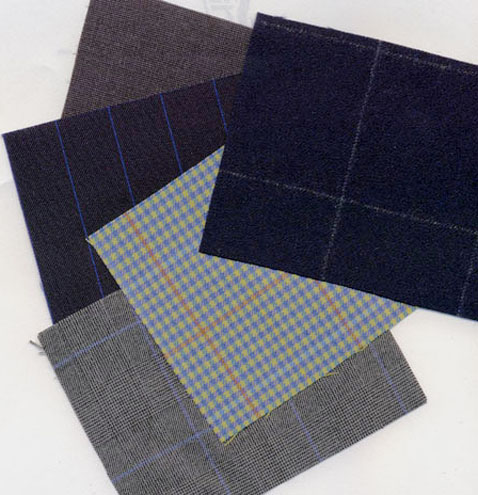| |
|
| |
• CLASSICS AND COLOURS FROM LONDON MERCHANT |
| |
A selection of cloth patterns from H. Lesser & Sons is shown here. They illustrate some of the prevailing trends as well as classic favourites.
|
| |
| |
 |
| |
| |
At top is a 30130, a 7 1/2/8oz Lumbs Huddersfield Golden Bale suiting; striped worsted suiting below no 29990, 11/12ozs; top right, example of soft worsted flannel suitings, with a chalk check, no 30642, 11/12oz; colourful check jacketing in Super 120s from the Carlo Barbera collection, exclusive to Lesser, 8 oz, no 29530; and bottom classic check worsted suiting, 11/12oz, no 30004. |
| |
We will show a selection of new patterns in the next edition. |
| |
|
|
|
|
| |
• can you wear brown for town? |
| |
| It is a hoary old question that still crops up and which we have ruled on before. Yes, indeed Brown is OK for Town. Quite how it ever came to be regarded as strictly informal we are at a loss to explain. The first modern short-cut suit jackets were all in Brown tweed, being based on 'The Tweedsie',an informal ensemble first worn by Prince Albert and male members of the Royal Family at their relaxed Scottish holiday home of Balmoral Castle. The short jacket was brought to town as a new style - and in brown. There are many fine formal suitings in the current bunches in all kinds of brown tones. And Brown may also be worn with Black, as long as it is a clear style statement. |
| |
|
|
|
|
| |
• CLOTH FORECASTS 40s REVIVAL
|
| |
|
Something of a 1940s revival is reported by top house, Hield. Their new collection features a number of retro designs from the 40s, which are fairly colourful. "We found that colour was strong then," says director Samer Chamsi-Pasha, "with ground effects of mid-blues, as well as the traditional greys and navys, and some aqua decorative effects." The cloth world has to be ahead of the game and if they are seeing a 40s look coming through expect to see this carried into styling too. That means a softer, draped look, wider lapels and pleated trousers. |
| |
|
|
|
|
|
| |
|
|
 |
| |
|
|
 |
:: A Natural Stretch :: |
| |
|
|
 |
STRETCH fibres have revolutionised the cloth and clothing industries since first introduced some 50-60 years ago. But taken to excess, they were responsible for some of the worst styles to be seen on High Streets everywhere, notably the stretch ski pant, leggings favoured by the fattest and shiny bicycle shorts. Not surprisingly, stretch went out of favour. But its judicious use has continued, in limited percentages, providing the 'give' in much modern clothing.
|
|
| |
|
|
| |
In Savile Row, however, this 'give' has generally been created through the use of quality natural fibre cloths and the expertise that goes into the make of the garment. But now top Yorkshire mill, Hield, has come up with a patented stretch fabric that they say can be done in any of their qualities, largely in100's. This may just tempt the Savile Row tailors. |
|
| |
|
|
| |
|
|
| |
|
|
| |
Fitted clothing obviously benefits from the 'give' factor. Our skin stretches enormously with every bending movement and a scientific measurement of different parts of our anatomy came up with some fascinating figures. Across the shoulders, the skin surface stretches by 15 per cent, the elbows by 19 per cent and the knee by 13 per cent, bottom by 5 per cent. But the vertical stretch is much greater - 40 per cent for the knees and elbows, nearly 30 per cent for the bottom when you bend over. |
|
| |
|
|
| |
Just like stretch fibres, the human skin finally loses its stretch recovery factor - which is why we wrinkle. |
|
| |
|
|
|
|
|
|
